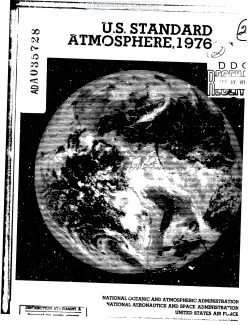DTIC-AD-A035728
- Version
- 270 Downloads
- 20.40 MB File Size
- 1 File Count
- March 5, 2017 Create Date
- March 5, 2017 Last Updated
U.S. Standard Atmosphere, 1976

The U.S. Standard Atmosphere, 1976, which is a revision of the U.S. Standard Atmosphere, 1962, was generated under the impetus of increased knowledge of the upper atmosphere obtained over the past solar cycle. Above 50 km, this Standard is based on extensive new rocket data and theory for the mesosphere and lower thermosphere, and on the vast resources of satel- lite data for the tYermosphere acquired over more than one complete solar Cycle. This Standard identical with the ICAO Standard (1964) up to 32 km and the ISO Standard (1973) to 50 km. Part 1 gives the basis for compu- tati01. of the main tables Of atmospheric properties, including values of physical constants, conversion factors, and definitions of derived properties. Part 2 describes the model and data used up to 85 km, in the first section; and the model and data used above 85 km, in the second section. The theoreti- cal basis of the high-altitude model is given in an appendix. Part 3 contains information on minor constituents in the troposphere, stratosphere, and mesosphere. The main tables Of atmospheric properties to 1000 km are given in Part 4. The international syse of metric units is used.
The US. Standard Atmosphere, 1976, with tables and graphs extending to 1000 km, was adopted by the United States Committee on Exten- sion to the Standard Atmosphere (COESA) in February 1975. This eAition is the Same as COESA's V.S. Standard Atmosphere, 1962" be- low 50 km, but replaces the 1962 Standard Atmo- sphere at higher altitudes. "hat. portion of the 1962 and 1976 U.S. Standard Ati„osphereg up to 32 km is identical with the In- ternational Civil Aviation Organization (ICAO) "Manual of the ICAO Standard Atmosphere," as revised in 1964 (International Civil Aviation Or- ganizution 1964). The definition of the lowest 50 km was recommended as the standard for inter- national adoption by the International Standards Organization (ISO) cognizant committee, ISO/ TC 20' SC 6, and appeared as • Draft International Standard ISO/ DIS 2533. It was approved by the ISO Member Bodies in September 1973 as the ISO Standard Atm08phere (ISO 1973). Addendum I to ISO/ DIS 2533, characteristics of the atmosphere from 50 to 80 km, has been included in the tables as the Interim Standard Atmosphere. The numer- iCal data in Addendum I also are identical with the data in this Standard. COESA has recommended that the ICAO also extend its standard atmosphere to 50 km, by accepting for its Own standard the definition of the 32- to 59-km region of the 1962 and 1976 U.S. Standard Atmosp}wre in order to insure a single, accepted international standard to the altitude of 50 km. The ICAO has not acted on this recommendation at the time of this publication.
| File | Action |
|---|---|
| DTIC-AD-A035728 U.S. Standard Atmosphere, 1976.pdf | Download |

Comment On This Post